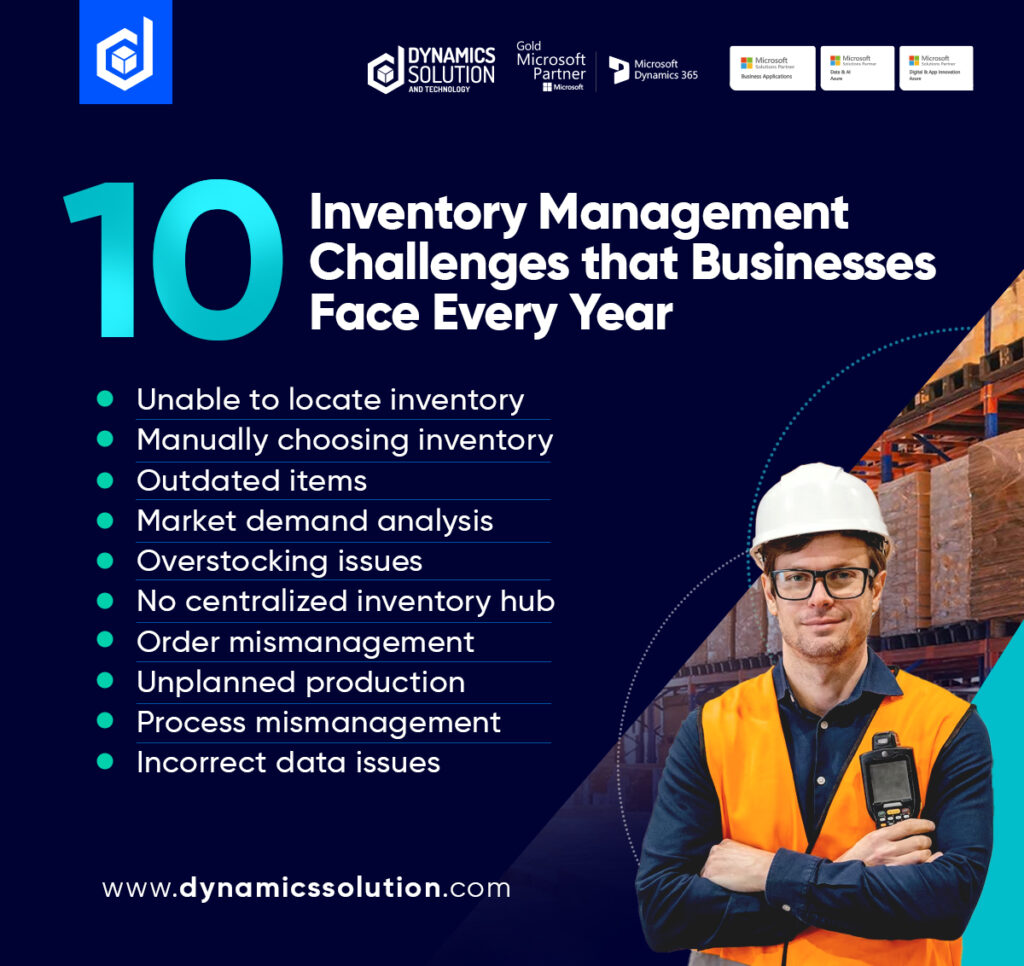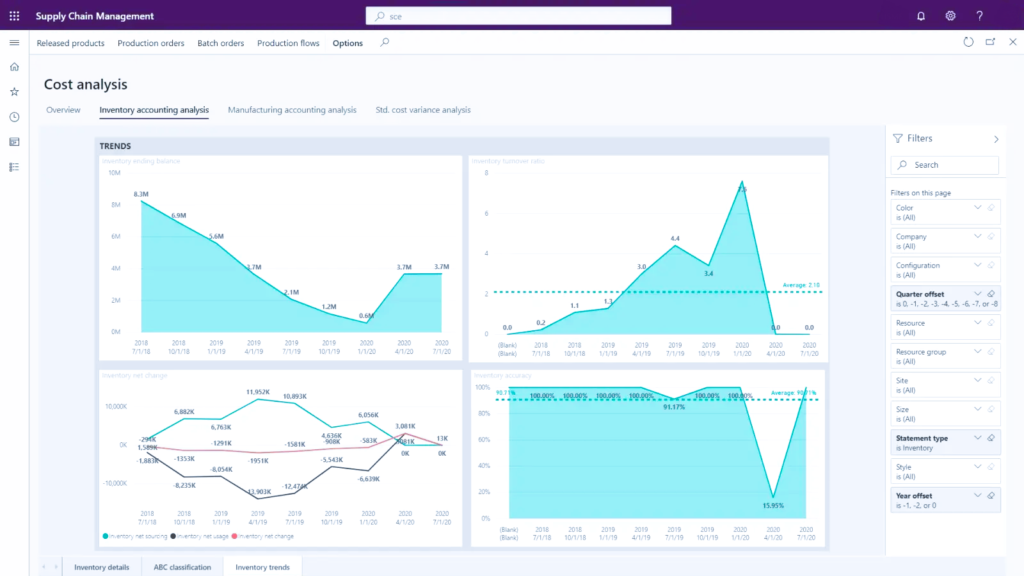In the dynamic business landscape, balancing between overstocking and understocking is paramount for profitability. The challenge lies in avoiding the pitfalls of overstocking, which burdens working capital, and leads to inventory obsolescence, lost sales, and dissatisfied customers. Simply put, this tightrope walks mandates precision in demand forecasting, real-time tracking, and supply chain agility.
In this blog, discover how using best practices, you can unlock the potential of seamless inventory control, ensuring smooth operations, heightened customer satisfaction, and a competitive edge in the market. Also, you will learn how Microsoft Dynamics 365 Business Central can assist you in accomplishing your inventory management goals to propel your business toward sustainable success.
What is Inventory Management?
Inventory refers to the materials or goods that are sold by an organization. Inventory management refers to the process of managing the inventory from the order stage all the way through to the closing of the sale. It involves ordering, storing, using, and selling a company’s stock.
The whole process may be broken down into its component parts, such as raw materials, parts, and completed goods, as well as the storage and processing of those items. You can do inventory management in a way that fits your business well, keeping in view the SWOT analysis results.
Basically, your goal should be to make certain that the appropriate materials or products are available at the appropriate time and location. To do so, you need to ensure that the required real-time inventory visibility is available to all of your respective stakeholders. In this way, it will allow your team to know when, how, and where stock order management is taking place.
What are Inventory Management Challenges?

Here is the list of ten inventory management challenges that businesses face every year:
- Unable to locate inventory.
Keeping track of inventory is one of the most challenging parts of inventory management and can create troubles. What if your stock ends on the transportation day? You have to make a late delivery which devalues the brand and lower ratings.
- Manually choosing inventory
Manual inventory tracking confuses, and it will cause issues in tracking product stock and delivery status, eventually preventing customers from ordering new items. Moreover, it can also cause issues in real-time data tracking.
- Outdated items
To keep products up-to-date and relevant to customer expectations, you must consistently update them. Keeping obsolete items in your inventory can cost you high loss while taking up valuable storage space.
- Market demand analysis
Your every single item’s market performance is crucial as its demand drives production and inventory expansion. Without a proper examination of the high-demand items and their respective regions can lead to product shortage and brand value loss.
- Overstocking issues
Keeping a keen eye on the items sold can save you a significant cost. You get a proper idea of the items needed to complete the existing stock. Ensure avoiding mismanagement in new stock acquisition and manually updating your orders to keep yourself safe from overstocking issues.
- No centralized inventory hub
Picture a scenario where your team has to flip multiple tabs excessively to get the client’s order details or track the order. It will not only frustrate them but also become a cause of low productivity. You need to make sure to centralize your every single conversation with the delivery team, and they have clear access to each order’s details.
- Order mismanagement
One of the hardest responsibilities is managing client orders to minimize overselling and stock-outs. You may face a challenge managing the orders by delivering them at the right time and spot. Client concerns resolved will directly affect your brand’s evaluations and ratings.
- Unplanned production
Your warehouse, which needs to receive the merchandise in time to match the demand-supply cycle, can cause discomfort. Slow manufacturing, scarcity of transportation, or delivery delays can cause inventory supply shortages. Try to avoid them.
- Process mismanagement
If your company is in the growing phase and currently only serves a smaller number of customers, go for Dynamics 365 Business Central inventory management solution. Forbes has already declared Dynamics 365 Business Central as the best cloud ERP Software (Overall). It will be your best investment for now and can help you a lot in mismanaged processes.
- Incorrect data issues
You would never like to sit down for long hours and list each item one by one, right? We know that the data you need to maintain can feel overwhelming and can cause incorrect data issues. With Microsoft Dynamics 365 Business Central, you can ensure data accuracy and availability every time.
Microsoft Dynamics 365 Business Central Inventory Management Software Overview
Dynamics 365 Business Central inventory management software empowers businesses to optimize inventory control effortlessly, striking the right balance between overstocking and understocking.
With real-time tracking, advanced forecasting, and data-driven analytics, you can make informed decisions, reduce carrying costs, and minimize stockouts. Moreover, you can also automate replenishment processes and improve supply chain efficiency to elevate operations and increase profitability.

The features enable users to monitor and control the management of stock items throughout their whole company. It retains a plethora of information about each product and regularly changes the stock levels based on the number of products sold and the number ordered.
In D365 Business Central, you can:
- Keep track of a comprehensive set of data on each inventory item, such as measurements, unit costs, sales prices, and much more.
- Organize the objects into hierarchical frameworks and give each category its own attributes.
- Locate products in stock and keep track of their movement when they are moved from one area to another.
- Compose a bill of materials by connecting necessary components.
- Automate the stock count in real time.
- Connect sold-out items to items that serve as replacements to provide customers with other options.
- Ensure proper management of things that are not supplied.
When should you upgrade from Dynamics 365 Business Central inventory management software?
Do you know most businesses have a common practice of underestimating the significance of inventory management, which includes calculating what to purchase, when to buy it, how much of it is essential, etc.?
Dynamics 365 Business Central inventory management is sufficient for your business, but only if you have a limited number of product lines, a relatively stable demand, a minimal number of suppliers, and consistent lead times. In short, you can easily cover the manual creation of projections and the calculation of order amounts with Business Central.
However, if your business has high aspirations about stock availability or you are planning to step up toward your business goals. In that case, you need to reconsider your Dynamics 365 Business Central decision because this software has limited capability and will not be sufficient for your business.
Are You in Need of a Solution for Your Inventory Management that Can Do More?
Dynamics Solution and Technology uses Microsoft Dynamics 365 Business Central inventory management software to facilitate our successful customers with their inventory needs. We understand how it feels to manually enter all the details and spend long hours and sometimes days streamlining your inventory.
Our team understands every single issue that can cause your business loss. We always offer assistance to our customers with everything that is necessary for running their e-commerce store or any other sort of business.
So, if you want us to take care of your inventory management needs that can save you from hurdles, talk to us, and consider it as your investment towards your business goal. We will make sure to provide you with customized solutions so that you will get an eye on all the aspects of your inventory.






